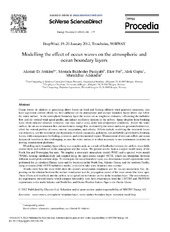| dc.description.abstract | Ocean waves, in addition to generating direct forces on fixed and floating offshore wind generator structures, also have significant indirect effects via their influence on the atmospheric and oceanic boundary layers above and below the water surface. In the atmospheric boundary layer the waves act as roughness elements, influencing the turbulent flow and the vertical wind speed profile, and induce oscillatory motions in the airflow. Spray droplets from breaking wave crests enhance structure corrosion, and may lead to icing under low-temperature conditions. Below the water surface, the air-sea momentum flux and mechanical energy flux, mediated by the waves and wave-generated turbulence, affect the vertical profiles of ocean current, temperature, and salinity. Effects include modifying the structural forces and dynamics, and the movement and dispersion of marine organisms, pollutants, and air bubbles generated by breaking waves, with consequences for fouling, corrosion, and environmental impact. Measurement of relevant airflow and ocean dynamical variables is also challenging, as near the water surface it is often necessary to use instruments mounted on moving measurement platforms. Modelling such boundary-layer effects is a complex task, as a result of feedbacks between the airflow, wave field, current field, and turbulence in the atmosphere and the ocean. We present results from a coupled model study of the North Sea and Norwegian Sea area. We employ a mesoscale atmosphere model (WRF) and a spectral wave model (WAM), running simultaneously and coupled using the open-source coupler MCEL which can interpolate between different model grids and time steps. To investigate the ocean boundary layer, one-dimensional model experiments were performed for an idealized Ekman layer and for locations in the North Sea, Atlantic Ocean, and the northern Pacific, using a version of the GOTM turbulence model, modified to take wave dynamics into account. Results show how the wave field alters the ocean’s aerodynamic roughness and the air–sea momentum flux, depending on the relation between the surface wind speed and the propagation speed of the wave crests (the wave age). These effects will feed back into the airflow, wind speed and turbulence profile in the boundary layer. The ocean dynamics experiments showed results which compare favourably with field observations from the LOTUS3 and PROVESS experiments in the north Atlantic and North Sea, and Ocean Weather Station Papa in the Pacific Ocean. | en_US |

